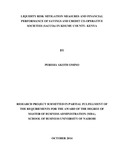| dc.description.abstract | SACCOs just like other financial institutions are obliged to generate income which is adequate to
cover all of their operational costs, inherent risks, and to enhance institutional capital. Given the
current ever-dynamic business environment, they are exposed to liquidity risk that affects their
financial performance. The objectives of the study were to analyze the liquidity risk mitigation
approaches effects on financial performance of SACCOs and to establish the quantitative
relationship between liquidity risk mitigation on liquidity levels and financial performance. The
targeted population for the study constituted all SACCOs in Kisumu County. Inclusion in the
population was determined by time of registration and operational activeness that were in
existence from the year 2009 and formally registered with KUSCCO. In this bracket, there were
62 population units spread across the seven sub-counties in Kisumu County. Data was
predominantly collected from prepared and availed financial statements, but supplemented by
questionnaire feedbacks. Available data was analyzed by relational and descriptive statistics, and
results presented in tables, models and graphs/charts.
The study found that liquidity risk mitigation approaches adopted by different SACCOs had a
significant effect on their financial performances. It was established that SACCOs adopted a
more cautious position in their current liabilities which ensured that operating cash flows were
sufficient to cover the short terms obligations entered by the firms. Also, the study found that
debtor collection periods were longer that optimality despite the fact that they were strategically
intended to sweeten voluntary membership, the SACCOs were either unjustifiably constraining
their creditor payment periods or were conditioned to do so, but oblivious of the operational
dangers.
In conclusion, the study recommended a consecrated effort towards deploying efficient systems
that seek to strengthen liquidity risk control fundamentals. The SACCOs needed professional
guidance towards adopting policies on asset and liability management so that precautionary
measures are undertaken on appropriate amounts of current liabilities to accept. Also SACCO
management needed to be sensitized on payable and receivable periods so that they established
the most yielding mark. Ideally, they needed relook at their strategies on shortening debt
collection (to avoid default risks) while lengthening credit payment period (to allows payables
transformation into a business financing source).Thus, self-optimization of the cash conversion
cycle. | en_US |

